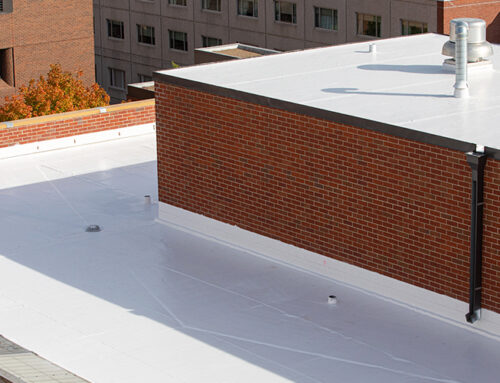Snow Roof Coating Information
Splits in the membrane, leaks, separations in seams, ridges, blisters and deterioration can all lead to roof failure, especially during the cold, icy winter months. If your flat commercial roof is old and showing signs of deterioration, restoring it with a roof coating now will save you money in the long run compared to having to do a complete tear-off later. Even if your building’s roof is brand-new, no roof is impervious to winter (or summer) weather extremes. That is why it’s important to address any repairs before winter arrives and safeguard your roof with an effective roof coating.
The Effects of Winter on Your Roof
There are two major culprits of commercial roof damage during the winter: temperature fluctuation and what’s called the freeze-thaw-freeze effect.
Temperature Fluctuations
When temperatures drop during the winter, the shift from warm to cold makes your roof contract. Then it expands as temperatures rise again.
We sometimes have those warmer days in the middle of winter when we can lighten our layers and snow begins to melt. It’s this type of fluctuation that really shocks your roof system, because the temperatures will inevitably drop again. The more extreme your area’s temperature fluctuations, the more your roof expands and contracts — weakening its structural integrity and risking premature roof failure.
Freeze-Thaw-Freeze Effect
Fluctuating temperatures during the winter lead to melting and freezing snow. The same fluctuation can create serious problems for your commercial roof. The freeze-thaw-freeze effect happens when snow falls on your roof, and heat from inside the building melts the first layer of snow. That melted snow seeps into open cracks and seams throughout the roof. As snow continues to fall, it re-freezes the melted snow, expanding the seams and cracks. This opens the cracks even wider and increases the chances of roof leaks and interior molding or damage. The thawing snow can also pool on a flat roof, weighing it down and stressing any existing defects. These natural but preventable problems can lead to costly repairs or even the need for a roof replacement.
Ways to Safeguard Your Commercial Roof
When snow begins to fall, check the drainage systems on your roof to avoid pooling or freezing water. Make sure all pipes, gutters and drains are clear so that the water can flow.
Of course, the best way to avoid roof failure is prevention. Before cold winter months arrive, have a professional roof inspector take a look at your commercial roof. You’ll be able to find any damage in need of repairing before it’s damaged even more by the cold and ice. This is a routine you should maintain year round to keep your roof in the best possible condition, whether you’re expecting a blizzard or a mild, sunny day. If cracks, leaks, or damage are found, you can then correct those defects with the appropriate coating to seal and reinforce your roof.
Older, more damaged roofs will fail more easily and quickly when exposed to weather extremes. By applying a roof coating, you will help extend the life of your roof and protect it from future winters. Whether you have a single-ply membrane or metal roof, coatings are a cost-effective method of protection, saving potential headaches and a lot of money down the road.
Our complete line of SEBS roof coatings offers options that are designed to withstand weather extremes and can be used on most commercial roofing types. If you just need to fill cracking seams on your roof, we can help you find the best coating products for your application and avoid incompatible coatings.
Before winter arrives in your region, get a head start on protecting your commercial roof by contacting Inland for the best roof coating solutions.



